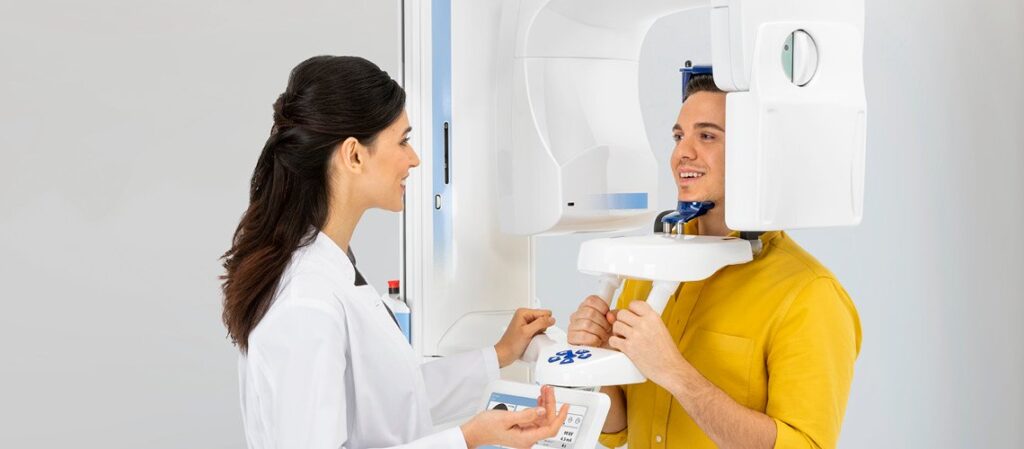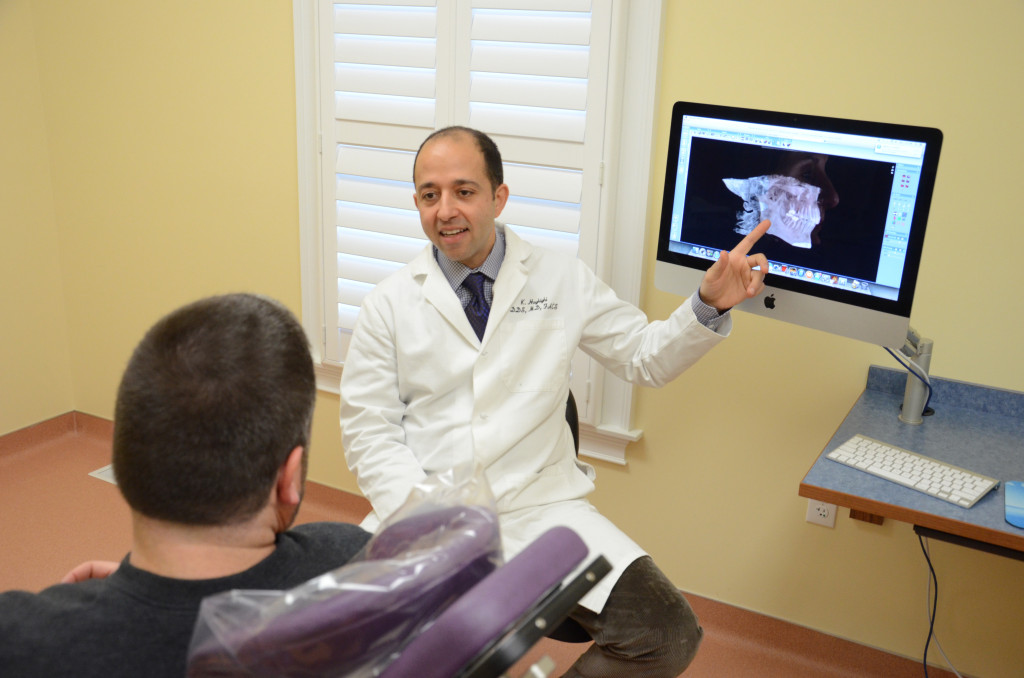
Facial reconstructive surgery relieves pain, restores range of motion, and enhances your appearance.
Maxillofacial surgery, or facial reconstructive surgery, deals specifically with injuries, deformities, and conditions related to the hard and soft tissue of the face. We know any type of surgery can be stressful, and the decision to move forward can be a difficult one. That’s why we go the extra mile to make sure you fully understand why we recommend each procedure and how it will help you function, feel, and look better.

Extraction of Wisdom Teeth
Wisdom teeth, or third molars, are the last teeth to develop and appear in your mouth. They come in between the ages of 17 and 25, a time of life that has been called the “Age of Wisdom.”
Wisdom teeth may not need to be extracted if they grow in completely and are functional, painless, cavity-free, disease-free, and in a hygienic environment with healthy gum tissue. They do, however, require regular, professional cleaning, annual check-ups, and periodic X-rays to monitor for any changes.
Watch this short video to learn more about Wisdom Teeth Management:
To learn more about these procedures or to schedule, an appointment call us at 732-530-1110
3D Imaging
Maxillofacial Surgery Center for Excellence utilizes computed tomography (CT) to generate 3D images for the diagnosis, planning, and treatment of surgery. This technology enables Dr. Haghighi to better assess facial trauma and obstructive sleep apnea. Unlike a traditional spiral CT scanner, our Planmeca Promax 3D system uses cone beam CT technology to provide precise, crystal clear digital images while minimizing exposure to radiation.
We also use 3D imaging technology to plan surgery and accurately predict the outcome of your procedure. We can actually move parts of the skeletal images to show what your face will look like after surgery. Computer-fabricated surgical guides allow for guided surgery, which minimizes operating time and ensures maximum precision – down to a fraction of a millimeter.
Our 3D imaging technology increases our in-office capabilities, which often results in fewer office visits for our patients. We can also quickly and easily share images with your referring doctor, allowing Dr. Haghighi to collaborate more effectively with other doctors in order to help you function, feel, and look better. Schedule a consultation to learn more about how you can benefit from our 3D imaging technology.
Cleft and Craniofacial Surgery
Cleft and craniofacial surgeries improve the quality of life by enabling basic, everyday functions like eating and speaking without pain or difficulty. These procedures also boost patients’ self-esteem by enhancing the form and appearance of the face.
Cleft lip, cleft palate, and craniosynostosis are usually addressed during childhood, but sometimes require corrective surgery during adulthood. Optimal treatment requires a multidisciplinary approach, with coordination between pediatricians, pediatric dentists, maxillofacial surgeons, otolaryngologists, and other professionals.
What is a cleft lip?
During early pregnancy, different areas of the face develop independently and then join together. This includes the left and right sides of the lips and the roof of the mouth. When these parts don’t join properly, it could result in a cleft, or opening, in the upper lip.
This cleft can range from a slight notch in the colored portion of the lip to a complete separation on one or both sides of the lip that extends into the nose. A cleft lip may correspond with a cleft in the gum, which can range from a small notch to a complete division of the gum. Surgery for a cleft lip removes any gaps or openings in the upper lip, gum, or the roof of the mouth to improve speech and appearance.
What is a cleft palate?
Similar to a cleft lip, a cleft palate occurs during early pregnancy when different areas of the face don’t join together properly, causing an opening in the roof of the mouth. The back of the palate is called the soft palate and the front is the hard palate.
A cleft palate can range from an opening at the back of the soft palate to a nearly complete separation of the entire roof of the mouth, including both the soft and hard palate. Surgery for a cleft palate closes any separation in the hard and soft palate, making it easier for patients to eat and speak.
What is craniosynostosis?
Craniosynostosis is the early fusion of the cranial suture lines. Cranial suture lines are incompletely calcified junctions between bones that allow the cranial vault to expand, creating room for the brain to grow during the first several years of life.
Craniosynostosis disrupts cranial vault expansion, causing craniofacial deformity, while the fusion of multiple suture lines can restrict growth and apply pressure on the brain. This can lead to neurological issues, including developmental problems, cognitive impairment, seizures, and mental retardation. Craniofacial surgery recreates suture lines at an early age to facilitate growth, correct deformity, and reduce the risk of neurological issues.
Corrective Aesthetic Jaw Surgery
Orthognathic surgery, or corrective jaw surgery, can improve chewing, speaking, breathing, and a facial appearance by repositioning a misaligned jaw. A jaw can be misaligned because of an injury, birth defect, or hereditary condition.
Corrective jaw surgery ensures that the upper and lower teeth meet correctly and function properly. While orthodontics can correct bite problems related to teeth, corrective jaw surgery is required when repositioning of the facial structure is necessary.
One major benefit of corrective jaw surgery is that one procedure can correct more than one problem. For example, if you undergo corrective jaw surgery to treat TMJ disorders, you could also correct obstructive sleep apnea or a facial deformity.
Schedule a consultation to learn more about corrective jaw surgery if you have:
- Difficulty with chewing, biting, or swallowing
- Speech problems
- Chronic jaw pain
- Pain from TMJ disorders
- Open bite
- Protruding jaw
- Obstructive sleep apnea
Facial Trauma
Facial trauma refers to injuries to the facial soft tissue (skin and gums), as well as fractures of facial bones, including the maxilla (upper jaw), a mandible (lower jaw), cheekbones, nasal bone, and eye sockets. It can also involve injuries to the eyes, facial nerves, and salivary glands.
Facial trauma is most commonly caused by car accidents, falls, sports injuries, work-related injuries and physical violence. We treat both the physical injury while giving special attention to the emotional needs of each patient.
Because these injuries are often the result of traumatic events, we believe the maxillofacial surgeon’s heart is as important as his knowledge. Dr. Haghighi is known for helping patients through the emotional highs and lows of facial trauma treatment. He draws upon his experience in emergency care, acute treatment, long-term reconstruction, and rehabilitation to provide patients with peace of mind while helping them feel, function, and look better.
The specific form of treatment for facial trauma is determined by a number of factors, including the location and severity of the injury, and the age and general health of the patient. Dr. Haghighi also looks for and treats related injuries to facial nerves, salivary glands, and salivary ducts.
Facial trauma can vary greatly with regards to severity and complexity, so please don’t hesitate to schedule a consultation and ask whatever questions you may have.
Bone Injuries of the Maxillofacial Region
Fractures of the bones of the face are treated in a manner similar to the fractures in other parts of the body. The specific form of treatment is determined by various factors, which include the location of the fracture, the severity of the fracture, the age, and the general health of the patient.
Fractures of the jaw are best treated and stabilized by the surgical placement of small plates and screws at the involved site. Fractures can be simple involving a single bone or more complex involving multiple bones. Surgical treatment of fractures is performed in an operating room setting in a hospital or surgicenter facility.
The treatment of facial fractures is designed to resume normal function and restore facial esthetics. An attempt at accessing the facial bones through the fewest incisions necessary is always made. At the same time, the incisions that become necessary, are designed to be small and, whenever possible, are placed so that the resultant scar is hidden.
Injuries To The Teeth & Surrounding Dental Structures
Isolated injuries to teeth are quite common and may require the expertise of various dental specialists. Oral surgeons usually are involved in treating fractures in the supporting bone or in replanting teeth that have been displaced or knocked out. These types of injuries are treated by one of a number of forms of splinting (stabilizing by wiring or bonding teeth together). If a tooth is knocked out, it should be placed in saltwater or milk. The sooner the tooth is re-inserted into the dental socket, the better chance it will survive. Therefore, the patient should see a dentist or oral surgeon as soon as possible. Never attempt to wipe the tooth off, since remnants of the ligament that hold the tooth in the jaw are attached and are vital to the success of replanting the tooth. Other dental specialists may be called upon, such as endodontists, who may be asked to perform root canal therapy, and/or restorative dentists who may need to repair or rebuild fractured teeth. In the event that injured teeth cannot be saved or repaired, dental implants are often now utilized as replacements for missing teeth.
The proper treatment of facial injuries is now the realm of specialists who are well versed in emergency care, acute treatment, long-term reconstruction, and rehabilitation of the injured patient.
Facial Trigeminal Nerve Surgery
The trigeminal nerve carries sensory perception from facial structures to the brain. Nerve injuries of the face can impact sensory nerves, as well as motor nerves that enable facial expression. The outer branches of the trigeminal nerve can be injured as a result of a dental procedure, jaw fracture, stroke, and other related causes.
Sensory nerve damage typically causes numbness or diminished sensory perception at first but can progress to persistent pain if left untreated. Trigeminal nerve microsurgery enables a surgeon to explore and examine the injured nerve under high-power magnification, identify the problem area, and repair the injury. Early diagnosis and surgical intervention can improve the chance of restoring normal sensation in the face.
The facial nerve provides motor function to the muscles that enable facial expression. Injury to this nerve can result in asymmetrical or uneven facial animation or complete paralysis of a portion of the face. This type of injury can be caused by a cranial base fracture or a penetrating injury such as a stabbing or gunshot.
Complete recovery from a facial nerve injury is possible with early identification and repair of the lacerations. However, the outcomes are less predictable when the facial nerve is injured near the cranial base. The resulting facial paralysis can be treated through a combination of surgery and physical therapy with the goal of enhancing facial animation and symmetry. Early diagnosis and treatment are critical, so schedule a consultation with Dr. Haghighi today.
Temporomandibular Joint Surgery
Temporomandibular joint (TMJ) disorders are complex conditions related to the jaw joints at the base of the skull, including the muscles, teeth, and nerves. All of the neuromuscular components must be in sync to enable proper chewing, breathing, and speaking. When the muscles are out of sync with the jaw joint, people experience the symptoms of TMJ disorders.
The most common symptoms are ear pain, headaches, difficulty with opening the mouth, and noises like popping and clicking. Conservative dental treatments will solve the problem for many patients, but surgical procedures ranging from diagnostic arthroscopic treatments to total joint reconstruction are often required to provide a more permanent solution to TMJ disorders.
Skeletal and dental deformities can be precursors to some TMJ disorders. Corrective jaw surgery, combined with orthodontics and appliance therapy, may be useful in the treatment of certain conditions. Schedule a consultation today to ensure the best possible treatment approach according to your specific diagnosis.









